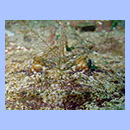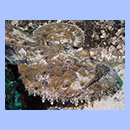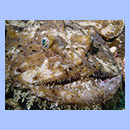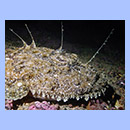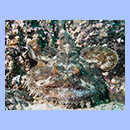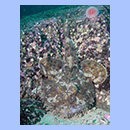- Kingdom: Animalia
- Phylum: Chordata
- Subphylum: Vertebrata
- Superclass: Gnathostomata
- Class: Actinopterygii
- Order: Lophiiformes
- Family: Lophiidae
- Scientific name: Lophius piscatorius
- Norwegian: breiflabb
Characteristics:
The monkfish cannot be mistaken with any other fish in Norwegian waters. It often hides partially buried in the sand, but the fin rays will reveal its hideout to an observant diver. Even on hard rock the camouflage works fine. With brown and grey patterns, often very well adapted to the surroundings, it is easily overlooked. The large flattened head constitutes half the body length. Like most other anglerfish it uses the first dorsal spine as a fishing pole with something looking like a bate in the end. When it suddenly opens its large, almost circular mouth, filled with sharp, thin, inward directed teeth, there is no escape for any prey sucked in with the water. When the monkfish is hiding on the bottom, its profile is framed by a large number of lobes. These disturb a otherwise distinct profile and thereby enhance the camouflage. The two large, rounded breast fins are located behind the head. They are spread out to stabilize the body when laying on the bottom. The ventral fins are small and hidden under the head. Large monkfish may reach a weight of 60 kg and a length of 2 meters. It feeds on fish, but is known to occasionally catch diving sea birds.
Habitat:
It thrives on a wide range of substrate where it hides while waiting for a passing prey. it can be found on any depth from just below the tidal zone and down to 1200 meters.
Distribution:
The monkfish can be found in the North-East Atlantic Ocean, from the Barents Sea to Gibraltar. It is also known from the Mediterranean.
